|
By Jerry Tardif
Editor's note: An excerpt of this article is published in the June 2009 issue of "Perfect Horse" magazine.
"Perfect Horse" also has articles about many other important aspects of horses, training, and their care — check them out!
Buying a new trailer is hard enough; we need to evaluate our needs against what is available, how well it's made, and what we can afford.
But at least we get to select amongst a host of options.
However, when considering a used trailer, the options become limited to what trailers are actually available on the market, and then we must add other concerns, such as the actual condition of the trailer, how it's been (or hasn't been) maintained, and hidden and unseen "wear and tear" (bearings, brakes, etc.)
So, how do we avoid buying the wrong trailer?
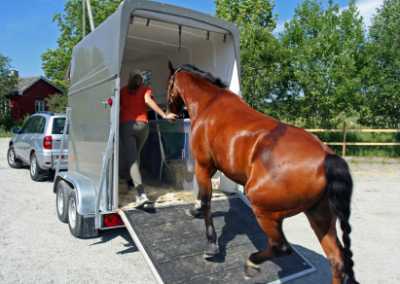
Trailer with a loading ramp.
It starts with an honest assessment of needs and a methodical approach to evaluation.
Start with these questions:
- How much weight can my tow vehicle safely pull?
- Will a stock trailer do?
- Do I need a tack or dressing room in my trailer?
- Do I really need to be able to haul four horses at a time or will a two-horse trailer get me by?
- Do I prefer a straight-load or slant-load?
- How much can I afford to spend?
The foregoing questions must be answered first.
You need to know what you actually require and can afford before knowing what to search for and how to vet it.
Once you know this, we can focus on evaluating the trailers themselves.
To keep this discussion less complex, we're going to focus on horse-only trailers and ignore travel/camper trailers at this time because of the greater complexities they add.
Steel or Aluminum?
Also, consider your feelings about trailers made of steel and aluminum?
Steel is stronger, but more prone to corrosion.
Aluminum is more corrosion resistant and more expensive.
Also realize, that while not nearly as susceptible to corrosion as iron products (e.g. steel) are to rusting, aluminum is susceptible to some forms of corrosion, such as pitting corrosion, crevice corrosion, and galvanic corrosion.
Therefore, you need to be on the lookout for signs of corrosion even when investigating an aluminum trailer.
Bring Your Tow Vehicle
When you go to examine a trailer for possible purchase, drive to it in your tow-vehicle.
You're going to want to ascertain compatibility BEFORE buying.
If the trailer has a ball hitch, ask the owner its size and make sure you have the proper size ball and a drawbar with you.
Also bring along a tape measure, a working flashlight, a notebook and pen or pencil, and a small screwdriver you can use to poke into wood flooring to check for soft spots or into a rusty joint to check the depth of that rust.
Now, let's start the examination using a methodical approach:
- Size – If you have standard size horses (up to 16-3 hh and approximately 1,600 pounds), a six-foot wide trailer will comfortably fit two without allowing too much room for them to bounce side to side during transport.
Go wider for bigger horses and drafts, but not so wide they can bounce around.
Make sure there's enough headroom, especially for bigger horses.
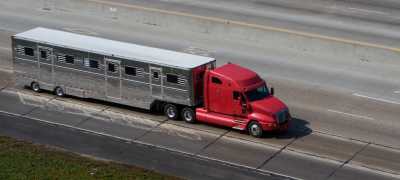
Don't get more trailer than you really need.
But, don't get significantly more trailer than you need.
A big trailer needs a correspondingly big tow vehicle.
Hauling around a large trailer with only one or two horses in it can be quite expensive and waste lots of fuel.
- Outward Appearance and Condition – How does the trailer look to you as you approach it?
Has it been well maintained or does it look rusty, all scraped up, or with neglected and faded paint?
While faded paint in and of itself is no big deal, the owner who makes little effort to keep his trailer looking goodlikely also hasn't likely spent much time or money maintaining the more important mechanical and electrical systems, so be thorough in your vetting process.
Presuming the trailer is on level or close to level ground, observe: is it sitting straight or leaning to one side?
What is the condition of the tires?
Do they show cracks or signs of dry rot?
Are they properly inflated or semi flat?
Look at the wear pattern on the tread — is it even?
If not, the trailer may have been operated frequently with under inflated tires, or worse, the axels could be bent — make a note for continued examination when underneath (yes, you'll have to go there).
While inspecting, ask the owner: when was the last time the trailer was used?
Did everything work properly?
Most owners will be honest, some won't.
But you'll get some idea if he/she hesitates and the honest owner could identify something you may not be able to find.
Keep checking: Does the trailer jack work?
If so, does it operate smoothly?
What is the condition of the brakes?
Do they work properly?
Tires are crucially important to smooth ride and safety while hauling.
What condition are the tires in?
Are they properly inflated?
Is the wear pattern even?
- Hitch Type & Coupler – The most common trailer hitch is the bumper-pull.
But first, let me point out that the name is not accurate in that you'll not pull any horse trailer with a bumper hitch.
Rather, you'll use a weight carrying hitch, weight distribution hitch, or something bigger, such as a gooseneck or fifth wheel.
Inspect the coupler.
Does it appear that all the parts are there and in working order?
Has it been well-maintained or is it rusting?
Is it damaged?
You don't want to try to fix a damaged coupler — it must be replaced or you should move on to another trailer.
Are the safety chains attached and in good condition?
What about the coupler height?
With frame-mounted hitches, you can select a drawbar with the appropriate "drop" as long as the coupler and hitch heights are not too different.
Many of today's trucks are higher off the ground and older trailers may have couplers that are much lower than the hitch ball.
This can also be an issue when looking at larger trailers that use gooseneck or fifth wheel hitches.
In the case of a gooseneck, make sure the coupler is at least 8 - 10 inches above the bed of your truck or you won't be able to get a secure hitch and a level trailer traveling profile.
- Loading – What kind of gate does the trailer have?
Will your horse step up and back down while loading and unloading?
Or is a ramp a better choice for you?
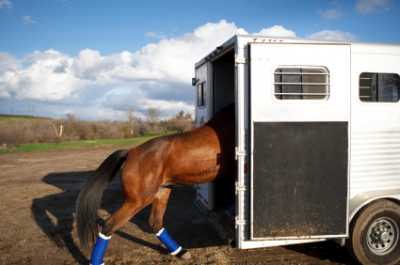
A Step-up trailer.
But we're discussing used trailers here — we can only choose from what's available on the market while we shop.
If your horses don't like a step-down, you have no choice but to move on to another trailer that offers a ramp.
- Floor – Thoroughly examine the trailer's floor.
Walk on it, even jump on it.
If it has mats, pull them up and take them out for a thorough inspection.
If the floor is made of wood, are there any holes or soft or spongy spots?
If so, the board(s) need to be replaced BEFORE you ever use the trailer.
Envision how you'd feel if your horse fell through a soft spot or hole, especially while underway.
Do you see any signs of insect damage or soft, spongy spots?
Check metal flooring for rust or corrosion.
- Inside Condition – Look at the dividers.
Are they secure?
Can they be removed and adjusted?
If so, unlatch them, adjust them, reattach them; do they all work smoothly?
What about butt bars and breast bars?
Are they all there?
Are they all secure?
Do they all operate smoothly?
Test them!
Is the wall padding in good condition?
Are all the any hay rings present and solid?
Is a water tank available?
If so, does it leak?
If it's made of metal, do you see any rust?
- Ventilation – Stock trailers have an open design with plenty of ventilation for the warmer months.
If you also have cold winters, does the trailer have Plexiglas windows for the winter or the ability for you to add them?
If not, you may not be able to transport your horses very far during the winter.
While horses can live a healthy existence outside throughout a winter, they need a run-in during windy days and an open trailer will similarly expose them to 40 - 50 MPH winds on a calm day, much more when driving into a head wind.
Without windows, using an open stock trailer to haul your horses during winter can expose them to serious risk of hypothermia.
Conversely, on an enclosed trailer, check for adequate ventilation.
Ventilation is important during the colder seasons and critical to survival during the summer.
Ventilation can be accomplished either via windows or by roof vents.
Whichever the trailer has, you need to be able open and close them, or to be able to leave them partially open depending on weather conditions.
Operate all the windows and vent; do they open, close, and latch smoothly and properly?
- Undercarriage – It's a dirty job, but somebody has to do it.
In this case, it's usually going to have to be you.
This means you need to get under the trailer with a good light and look around.
If on a hard surface (e.g. concrete or asphalt), a creeper will make the job easier and a little less uncomfortable (notice I didn't say "comfortable").
What are you looking for?
Search for rust, dents, and other signs of damage from rough driving, a prior accident, deterioration, and general neglect.
You don't want to buy a trailer that's falling apart — it's not a good bargain at any price because the cost of refurbishment is too expensive in most cases, and using it "as is" will often be unsafe and possibly illegal.
Also look for leaks, such as oil from the axel housing.
Consider asking an auto-savvy friend to help or paying a mechanic.
This would be money very well spent, if even because he tells you not to sink any hard-earned money into a dud of a trailer.
Look for:
- Loose or missing bolts;
- Frayed, exposed, or broken wiring;
- A cracked or broken axel housing, frame members, or any other structural member;
- Look up at the underside of the floor.
How does it look?
If wood, do you see any water stains that could imply rot?
If so, poke that screwdriver into it — it should be hard, not soft, and should definitely not go through.
Do you see any damage or light coming through from above?
If you do see light, is that from a small intentionally drilled hole or does the floor look as if it's about to fall out?
If a steel floor, are there signs of rust?
If an aluminum floor, do you see signs of corrosion?
Whether steel or aluminum, if rust or corrosion is present, how bad is it?
Also, how many cross members are there?
The more there are, the stronger the floor;
- Check for cracking and/or dry rot on the tires (some people will reverse a tire to put the bad side facing in so a prospective buyer can't see it);
- Look at how the hitch is attached to the trailer and its general condition; does it look sound and secure?
This is your opportunity to truly see the condition of the trailer.
Those sellers that try to misrepresent a trailer will not likely have spent time hiding the trailer's true condition underneath.
So, if it looks like it's in good shape there, it very likely is.
- Spare Tire – Does the trailer have a spare tire?
Many trailers come without one.
Is it important to you that one is included?
It is to me.
It's bad enough to get stranded by yourself, worse to be stranded somewhere with your horse and no way to get him and you safely home again.
So, I want a spare tire on my trailer.
However, if the trailer otherwise passes your inspection, you can always have a spare tire added after you buy it.
If it does have a spare, then you want to determine its condition.
If the tire shows signs of excessive wear or dry rot, you'll have to replace it.
At least you'll have the wheel and a place to mount it on the trailer.
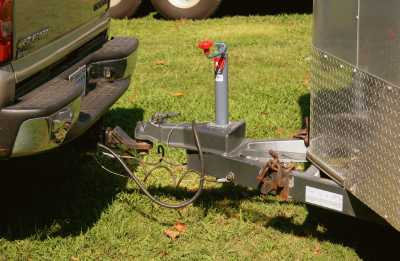
Inspect the coupler on a used trailer.
If it's damaged, that can be a deal-breaker.
- Hook-up – Attach the trailer to your tow vehicle.
Is the hitch on your tow vehicle and the coupler on the trailer at a good working height in relation to one another?
If not, perhaps you can't pull this trailer with your current truck.
You'll need to go to a trailer store and speak with an expert to investigate further.
- Electrical – Do the electrical connectors mate?
If not, you'll either have to change it or buy an adapter.
Turn on the parking lights and check that the tail lights and any running lights are all properly lit.
Apply the brakes and assure the stop lights come on.
Test the directional signal lights and four-way flashers.
If the trailer has a dome light inside, turn it on to assure it works and do the same with any other lights, such as in the tack/dressing room if the trailer has one.
Are there one or more fans for ventilation?
If so, test that they work.
- Driving Test – What, you ask?
You test-drive a vehicle or a boat before buying, don't you?
Why would you buy a trailer without determining for yourself whether or not it feels right and whether the brakes actually work?
Of course, get the owner's permission first.
If they're even half smart, they'll want to come along (some trailer thefts occur this way).
- Slow Speed Test – Make sure the hitch is secured and the safety chains attached, and begin to pull the trailer.
Start driving at walking speed to determine if everything feels right.
If so, accelerate to about 10 MPH.
Does the trailer haul effortlessly or drag?
Does it pull to one side?
Apply the brakes; does it feel as if you have adequate stopping power in an emergency?
Does the trailer pull to one side when the brakes are applied?
Does the trailer fishtail when driving or braking?
- Moderate Speed Test – Next, accelerate to a reasonable hauling speed, such as 35 - 45 MPH.
Does the trailer feel stable or are you concerned about control or safety?
If stable, does it track in a straight pattern behind you or does it sway?
Slow down and then stop.
Did you have any concerns that the trailer would stop in time and that you were in full control?
If you had to stop the test drive at any step because a problem became obvious, you need to assess whether or not this trailer can be inexpensively fixed or if it should be dropped from continued consideration.
- Breakaway Brake Test – Test the breakaway brake.
To do that, pull its clip and try to slowly pull the trailer forward with your tow vehicle.
The trailer shouldn't move because the breaks should be full on.
Don't leave the breakaway brake on for very long because the battery will discharge — it only lasts for about 40 - 60 seconds and will require recharging.
But if you're going to consider buying this trailer, you need to know whether or not such an emergency piece of equipment is in good working order.
If it doesn't work, the only problem might be that the battery is dead.
Regardless, if you bought the trailer, the law mandates that it must be operational before you can tow the trailer home, so the current owner should have already assured it is charged and operational.
If not, that fact alone raises other questions as to the condition of the trailer.
- Warranty – Once you finish your inspection and test drive, it's time to speak with the trailer's owner.
If the trailer is fairly new, ask the owner if there's a warranty still in effect.
If so, ask if it can be transferred to you as a new owner — some warranties allow this.
If it's an older trailer, ask to see past service records, invoices, etc.
Many owners keep this information, and if available, it will allow you to assess the care given this trailer.
- Negotiate – By this time, your checklist should identify your concerns, the trailer's weaknesses, and its strong points.
If there are any structural or mechanical concerns, ask the owner if there's any problem with you having your mechanic or body specialist comeback to look at them.
If the owner objects, drop this trailer fromconsideration — you can't take a chance on buying defective equipment in these important areas.
If the trailer is in good mechanical condition, the only items on your list will have to do with things you can fix yourself, such as floorboard replacement, a new coat of paint, replacement of padding, ventilation fans, hay rings, etc.
But, there's no reason these items can't be used to negotiate the price down somewhat to compensate for your need to expend more money to fix or replace them.
- Best Price – You should also look at trailer ads so you can get a feeling for typical prices of similar trailers in similar condition.
Compare the best price the owner will allow you to other trailers you've seen.
Is it in the "ballpark?"
Is this a good price?
Now, assess your overall impression.
Does this trailer feel "right?"
If not, are there problems that can be reasonably resolved, either with the owner, or by a small investment of cash to repair/replace problem components?
Resist the temptation to buy a severely compromised trailer at a bargain price with the intention of fixing it or modifying it yourself — this can be a real trap into which many have fallen.
Unless you're trained and have access to a body shop with experience using the tools, you're quite limited in what you can fix or add yourself, let alone getting it certified for legal use on the road.
And if you're prepared to spend money to have a professional body shop do the work, consider that it may be cheaper to look for other trailers in better condition with the options you want.
Depending on the problems, it may even be cheaper to buy new.
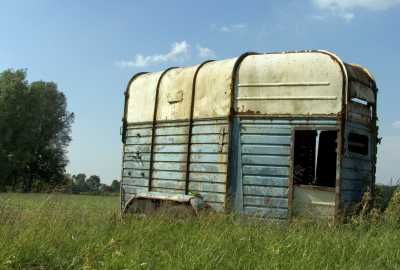
Don't buy a trailer just because it's cheap.
Finally, consider the economic climate and prices of similar trailers — you don't want to pay more than you have to.
If the trailer really is what you want, but unaffordable, discuss that with the owner.
They likely want to sell the trailer as much as you want to buy it.
Some honest dialog can often bridge a seemingly wide gap to meet a middle ground comfortable for both parties.
To help you be consistent and thorough as you examine several trailers, use the checklist included here to compare apples to apples.
Used Trailer Buying Checklist
Besides being an avid trail rider, Jerry Tardif is a technology consultant and a horse and nature photographer in SE Connecticut — see his work at: www.jerrytardif.com.
He is also co-founder and President of QueryHorse.
Back to Article Index
|